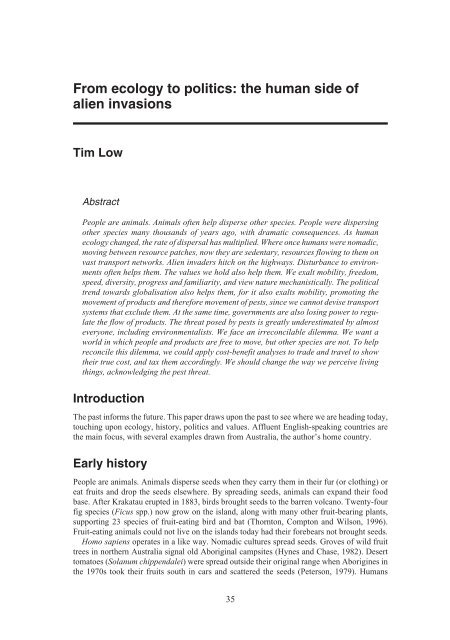Alien Species.vp - IUCN
Alien Species.vp - IUCN
Alien Species.vp - IUCN
Create successful ePaper yourself
Turn your PDF publications into a flip-book with our unique Google optimized e-Paper software.
From ecology to politics: the human side of<br />
alien invasions<br />
Tim Low<br />
Abstract<br />
People are animals. Animals often help disperse other species. People were dispersing<br />
other species many thousands of years ago, with dramatic consequences. As human<br />
ecology changed, the rate of dispersal has multiplied. Where once humans were nomadic,<br />
moving between resource patches, now they are sedentary, resources flowing to them on<br />
vast transport networks. <strong>Alien</strong> invaders hitch on the highways. Disturbance to environments<br />
often helps them. The values we hold also help them. We exalt mobility, freedom,<br />
speed, diversity, progress and familiarity, and view nature mechanistically. The political<br />
trend towards globalisation also helps them, for it also exalts mobility, promoting the<br />
movement of products and therefore movement of pests, since we cannot devise transport<br />
systems that exclude them. At the same time, governments are also losing power to regulate<br />
the flow of products. The threat posed by pests is greatly underestimated by almost<br />
everyone, including environmentalists. We face an irreconcilable dilemma. We want a<br />
world in which people and products are free to move, but other species are not. To help<br />
reconcile this dilemma, we could apply cost-benefit analyses to trade and travel to show<br />
their true cost, and tax them accordingly. We should change the way we perceive living<br />
things, acknowledging the pest threat.<br />
Introduction<br />
The past informs the future. This paper draws upon the past to see where we are heading today,<br />
touching upon ecology, history, politics and values. Affluent English-speaking countries are<br />
the main focus, with several examples drawn from Australia, the author’s home country.<br />
Early history<br />
People are animals. Animals disperse seeds when they carry them in their fur (or clothing) or<br />
eat fruits and drop the seeds elsewhere. By spreading seeds, animals can expand their food<br />
base. After Krakatau erupted in 1883, birds brought seeds to the barren volcano. Twenty-four<br />
fig species (Ficus spp.) now grow on the island, along with many other fruit-bearing plants,<br />
supporting 23 species of fruit-eating bird and bat (Thornton, Compton and Wilson, 1996).<br />
Fruit-eating animals could not live on the islands today had their forebears not brought seeds.<br />
Homo sapiens operates in a like way. Nomadic cultures spread seeds. Groves of wild fruit<br />
trees in northern Australia signal old Aboriginal campsites (Hynes and Chase, 1982). Desert<br />
tomatoes (Solanum chippendalei) were spread outside their original range when Aborigines in<br />
the 1970s took their fruits south in cars and scattered the seeds (Peterson, 1979). Humans<br />
35












